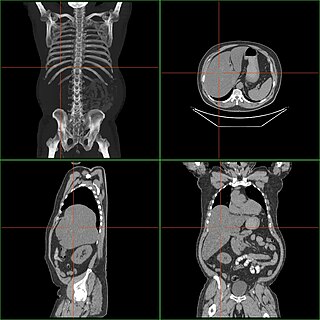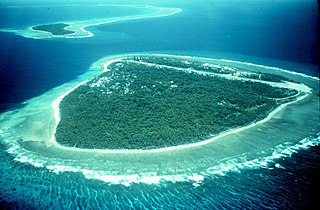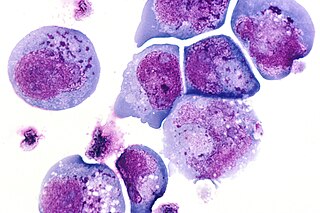Related Research Articles

Copepods are a group of small crustaceans found in nearly every freshwater and saltwater habitat. Some species are planktonic, some are benthic, a number of species have parasitic phases, and some continental species may live in limnoterrestrial habitats and other wet terrestrial places, such as swamps, under leaf fall in wet forests, bogs, springs, ephemeral ponds, and puddles, damp moss, or water-filled recesses (phytotelmata) of plants such as bromeliads and pitcher plants. Many live underground in marine and freshwater caves, sinkholes, or stream beds. Copepods are sometimes used as biodiversity indicators.

Vibrio is a genus of Gram-negative bacteria, possessing a curved-rod (comma) shape, several species of which can cause foodborne infection, usually associated with eating undercooked seafood. Typically found in salt water, Vibrio species are facultative anaerobes that test positive for oxidase and do not form spores. All members of the genus are motile. They are able to have polar or lateral flagellum with or without sheaths. Vibrio species typically possess two chromosomes, which is unusual for bacteria. Each chromosome has a distinct and independent origin of replication, and are conserved together over time in the genus. Recent phylogenies have been constructed based on a suite of genes.

Liver disease is a type of damage to or disease of the liver. Whenever the course of the problem lasts long, chronic liver disease ensues.

Hepatomegaly is the condition of having an enlarged liver. It is a non-specific medical sign having many causes, which can broadly be broken down into infection, hepatic tumours, or metabolic disorder. Often, hepatomegaly will present as an abdominal mass. Depending on the cause, it may sometimes present along with jaundice.

Vancomycin-resistant Enterococcus, or vancomycin-resistant enterococci (VRE), are bacterial strains of the genus Enterococcus that are resistant to the antibiotic vancomycin.

Many species of fish are consumed as food in virtually all regions around the world. Fish has been an important source of protein and other nutrients for humans throughout history.

A sea louse, is a member of the Caligidae family of copepods within the order Siphonostomatoida. The roughly 559 species in 37 genera include around 162 Lepeophtheirus and 268 Caligus species. Sea lice are marine ectoparasites that feed on the mucus, epidermal tissue, and blood of host marine fish.
Brooklynella hostilis is a parasite of marine fish, found in wild fish, farmed fish and aquariums. It is kidney-bean shaped, and approximately 60–80 μm long, with bands of cilia. B. hostilis is the only species in the monotypic taxon Brooklynella, a genus in the order Hartmannulidae. It reproduces by binary fission.
Animal viruses are viruses that infect animals. Viruses infect all cellular life and although viruses infect every animal, plant, fungus and protist species, each has its own specific range of viruses that often infect only that species.

The salmon louse is a species of copepod in the genus Lepeophtheirus. It is a sea louse, a parasite living mostly on salmon, particularly on Pacific and Atlantic salmon and sea trout, but is also sometimes found on the three-spined stickleback. It feeds on the mucus, skin and blood of the fish. Once detached, they can be blown by wind across the surface of the sea, like plankton. When they encounter a suitable marine fish host, they adhere themselves to the skin, fins, or gills of the fish, and feed on the mucus or skin. Sea lice only affect fish and are not harmful to humans.

Like humans and other animals, fish suffer from diseases and parasites. Fish defences against disease are specific and non-specific. Non-specific defences include skin and scales, as well as the mucus layer secreted by the epidermis that traps microorganisms and inhibits their growth. If pathogens breach these defences, fish can develop inflammatory responses that increase the flow of blood to infected areas and deliver white blood cells that attempt to destroy the pathogens.
Bacterial kidney disease is a systemic infection caused by the bacterium Renibacterium salmoninarum. The disease affects populations of wild salmonid. BKD was originally discovered in the Scottish rivers of Dee and Spey in 1933.

Human impact on coral reefs is significant. Coral reefs are dying around the world. Damaging activities include coral mining, pollution, overfishing, blast fishing, the digging of canals and access into islands and bays. Other dangers include disease, destructive fishing practices and warming oceans. Factors that affect coral reefs include the ocean's role as a carbon dioxide sink, atmospheric changes, ultraviolet light, ocean acidification, viruses, impacts of dust storms carrying agents to far-flung reefs, pollutants, algal blooms and others. Reefs are threatened well beyond coastal areas. Climate change, such as warming temperatures, causes coral bleaching, which if severe kills the coral.

This article is about diseases and parasites in salmon, trout and other salmon-like fishes of the family Salmonidae.
Tenacibaculum soleae is a bacterium. It is a fish pathogen for some species of sole, brill and turbot, with a particularly high mortality rate. It is Gram-negative, rod-shaped and gliding. Its type strain is LL04 12.1.7T.

Activated PI3K delta syndrome is a primary immunodeficiency disease caused by activating gain of function mutations in the PIK3CD gene. Which encodes the p110δ catalytic subunit of PI3Kδ, APDS-2 (PASLI-R1) is caused by exon-skipping mutations in PIK3R1 which encodes for the regulatory subunit p85α. APDS and APDS-2 affected individuals present with similar symptoms, which include increased susceptibility to airway infections, bronchiectasis and lymphoproliferation.

Human Herpes Viruses, also known as HHVs, are part of a family of DNA viruses that cause several diseases in humans. One of the most notable functions of this virus family is their ability to enter a latent phase and lay dormant within animals for extended periods of time. The mechanism that controls this is very complex because expression of viral proteins during latency is decreased a great deal, meaning that the virus must have transcription of its genes repressed. There are many factors and mechanisms that control this process and epigenetics is one way this is accomplished. Epigenetics refers to persistent changes in expression patterns that are not caused by changes to the DNA sequence. This happens through mechanisms such as methylation and acetylation of histones, DNA methylation, and non-coding RNAs (ncRNA). Altering the acetylation of histones creates changes in expression by changing the binding affinity of histones to DNA, making it harder or easier for transcription machinery to access the DNA. Methyl and acetyl groups can also act as binding sites for transcription factors and enzymes that further modify histones or alter the DNA itself.
Tenacibaculum is a Gram-negative and motile bacterial genus from the family of Flavobacteriaceae.
Exophiala pisciphila is a mesophilic black yeast and member of the dark septate endophytes. This saprotrophic fungus is found commonly in marine and soil environments. It is abundant in harsh environments like soil contaminated with heavy metals. E. pisciphila forms symbiotic relationships with various plants by colonizing on roots, conferring resistance to drought and heavy metal stress. It is an opportunistic pathogen that commonly causes infections in captive fish and amphibians, while rarely causing disease in humans. Secondary metabolites produced by this species have potential clinical antibiotic and antiretroviral applications.
Maul's searsid, also called Maul's tubeshoulder, is a species of fish in the family Platytroctidae (tubeshoulders), named for Günther Maul.
References
- 1 2 "Tenacibaculum". LPSN .
- 1 2 3 "Tenacibaculum maritimum". www.uniprot.org.
- ↑ "Tenacibaculum lutimaris Taxon Passport - StrainInfo". www.straininfo.net.
- 1 2 "Details: DSM-17995". www.dsmz.de.
- ↑ Bruno, David W.; Noguera, Patricia A.; Poppe, Trygve T. (2013). A Colour Atlas of Salmonid Diseases. Springer Science & Business Media. ISBN 9789400720107.
- ↑ "Flexibacter maritimus sp. nov., a Pathogen of Marine Fishes" (PDF). www.microbiologyresearch.org.
- 1 2 Avendaño-Herrera, R; Toranzo, AE; Magariños, B (2006). "Tenacibaculosis infection in marine fish caused by Tenacibaculum maritimum: a review". Diseases of Aquatic Organisms. 71 (3): 255–266. doi: 10.3354/dao071255 . PMID 17058606.
- ↑ MacKenzie, Simon A.; Jentoft, Sissel (2016). Genomics in Aquaculture. Academic Press. ISBN 9780128016909.